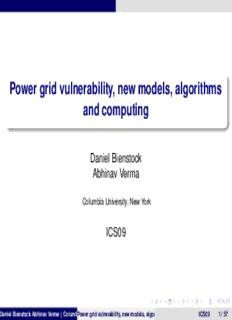
Power grid vulnerability, new models, algorithms and computing PDF
Preview Power grid vulnerability, new models, algorithms and computing
Power grid vulnerability, new models, algorithms and computing Daniel Bienstock Abhinav Verma ColumbiaUniversity,NewYork ICS09 DanielBienstockAbhinavVerma(ColumbPiaoUwneirvgerrisditvy,uNlneewraYboilrikty),newmodels,algorithmsandcomputing ICS09 1/57 The N-k problem in power grids Given a power grid modeled by a network, delete a small set of arcs, such that in the resulting network all feasible flows have small throughput Used to model “natural” blackouts “Small” throughput: we satisfy less than some amount Dmin of total demand “Small” set of arcs = very small Delete 1 arc = the “N-1” problem Of interest: delete k = 2,3,4,... edges Naive enumeration blows up DanielBienstockAbhinavVerma(ColumbPiaoUwneirvgerrisditvy,uNlneewraYboilrikty),newmodels,algorithmsandcomputing ICS09 2/57 The N-k problem in power grids Given a power grid modeled by a network, delete a small set of arcs, such that in the resulting network all feasible flows have small throughput Used to model “natural” blackouts “Small” throughput: we satisfy less than some amount Dmin of total demand “Small” set of arcs = very small Delete 1 arc = the “N-1” problem Of interest: delete k = 2,3,4,... edges Naive enumeration blows up DanielBienstockAbhinavVerma(ColumbPiaoUwneirvgerrisditvy,uNlneewraYboilrikty),newmodels,algorithmsandcomputing ICS09 2/57 The N-k problem in power grids Given a power grid modeled by a network, delete a small set of arcs, such that in the resulting network all feasible flows have small throughput Used to model “natural” blackouts “Small” throughput: we satisfy less than some amount Dmin of total demand “Small” set of arcs = very small Delete 1 arc = the “N-1” problem Of interest: delete k = 2,3,4,... edges Naive enumeration blows up DanielBienstockAbhinavVerma(ColumbPiaoUwneirvgerrisditvy,uNlneewraYboilrikty),newmodels,algorithmsandcomputing ICS09 2/57 The N-k problem in power grids Given a power grid modeled by a network, delete a small set of arcs, such that in the resulting network all feasible flows have small throughput Used to model “natural” blackouts “Small” throughput: we satisfy less than some amount Dmin of total demand “Small” set of arcs = very small Delete 1 arc = the “N-1” problem Of interest: delete k = 2,3,4,... edges Naive enumeration blows up DanielBienstockAbhinavVerma(ColumbPiaoUwneirvgerrisditvy,uNlneewraYboilrikty),newmodels,algorithmsandcomputing ICS09 2/57 The N-k problem in power grids Given a power grid modeled by a network, delete a small set of arcs, such that in the resulting network all feasible flows have small throughput Used to model “natural” blackouts “Small” throughput: we satisfy less than some amount Dmin of total demand “Small” set of arcs = very small Delete 1 arc = the “N-1” problem Of interest: delete k = 2,3,4,... edges Naive enumeration blows up DanielBienstockAbhinavVerma(ColumbPiaoUwneirvgerrisditvy,uNlneewraYboilrikty),newmodels,algorithmsandcomputing ICS09 2/57 The N-k problem in power grids Given a power grid modeled by a network, delete a small set of arcs, such that in the resulting network all feasible flows have small throughput Used to model “natural” blackouts “Small” throughput: we satisfy less than some amount Dmin of total demand “Small” set of arcs = very small Delete 1 arc = the “N-1” problem Of interest: delete k = 2,3,4,... edges Naive enumeration blows up DanielBienstockAbhinavVerma(ColumbPiaoUwneirvgerrisditvy,uNlneewraYboilrikty),newmodels,algorithmsandcomputing ICS09 2/57 The N-k problem in power grids Given a power grid modeled by a network, delete a small set of arcs, such that in the resulting network all feasible flows have small throughput Used to model “natural” blackouts “Small” throughput: we satisfy less than some amount Dmin of total demand “Small” set of arcs = very small Delete 1 arc = the “N-1” problem Of interest: delete k = 2,3,4,... edges Naive enumeration blows up DanielBienstockAbhinavVerma(ColumbPiaoUwneirvgerrisditvy,uNlneewraYboilrikty),newmodels,algorithmsandcomputing ICS09 2/57 Linear power flow model We are given a network G with: A set of S of supply nodes (the “generators”); for each generator i an “operating range” 0 ≤ SL ≤ SU, i i A set D of demand nodes (the “loads”); for each load i a “maximum demand” 0 ≤ Dmax. i For each arc (i,j) values x and u . ij ij DanielBienstockAbhinavVerma(ColumbPiaoUwneirvgerrisditvy,uNlneewraYboilrikty),newmodels,algorithmsandcomputing ICS09 3/57 Linear power flow model We are given a network G with: A set of S of supply nodes (the “generators”); for each generator i an “operating range” 0 ≤ SL ≤ SU, i i A set D of demand nodes (the “loads”); for each load i a “maximum demand” 0 ≤ Dmax. i For each arc (i,j) values x and u . ij ij DanielBienstockAbhinavVerma(ColumbPiaoUwneirvgerrisditvy,uNlneewraYboilrikty),newmodels,algorithmsandcomputing ICS09 3/57
Description: